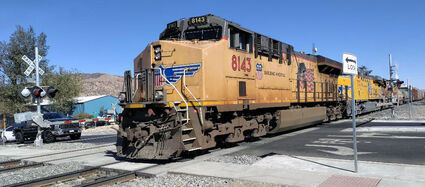Union Pacific Railroad
Train Talk
April 30, 2022
The Union Pacific Railroad, or just UP as it is commonly called, is a freight-hauling railroad that operates 8,300 locomotives over 32,200 miles routes in 23 U.S. states west of Chicago and New Orleans.
Union Pacific is the second largest railroad only to the BNSF in the United States. Founded in 1862, the original Union Pacific Railroad was part of the First Transcontinental Railroad project, later known as the Overland Route.
The original rail line was built westward 1,006 miles from Omaha, Nebraska, to meet the Central Pacific, which was being built eastward from Sacramento, California. The two railroads were joined at Promontory, Utah on May 10, 1869.
It's been over 130 years since the railroad came to Tehachapi.
In 1867, the Southern Pacific, filed a map of the route the company would take starting at San Francisco and coming into the San Joaquin Valley. The track would then turn south into the Tehachapi Mountains toward Mojave. The railroad would run through Bakersfield on the north bank of the Kern River and they built a terminal at Sumner in 1874. The location of the terminal was in a great location as Bakersfield was subject to flooding in downtown along Chester Avenue by the Kern River.
Then, in 1875, a temporary railroad track line reached Caliente, where the railroad recruited more than 3,000 Chinese laborers to continue the line all the way to Tehachapi. Business and land deals boomed in Caliente as the railroad made profits by hauling freight.
Construction of the line was not difficult until the Tehachapi mountain range came into play. Engineers faced the problem of rising 4,000 feet to traverse 46 miles up the mountain.
The best grade through the region was the Tehachapi Pass, located along the northwestern section of the mountain range, and is where they ultimately decided to lay its line.
The loop was constructed as part of Southern Pacific's main line through Southern California, which had to cross the Tehachapi Mountain range. The intent was to gain elevation at a manageable gradient and has worked so well for nearly 125 years that it has remained virtually unchanged and in regular use.
The Tehachapi Loop is a 3,779-foot long spiral, or helix, on the Union Pacific Railroad Mojave Subdivision through Tehachapi Pass, of the Tehachapi Mountains in Kern County, south-central California. The line connects Bakersfield and the San Joaquin Valley to Mojave in the Mojave Desert. The tracks ran through Tehachapi where a depot was built. Locals were able to grow and procure a profit from hay, potatoes, lumber, wheat, barley, apples and pears in the areas of Brite Valley, Cummings Valley and Bear Valley, and load the sold goods at packing houses near the railroad tracks.
The original Tehachapi depot burned down in February 1904, sparked by an oil leak on a Santa Fe passenger train engine. It was rebuilt in the summer of 1904 and used until 1971.
Erected in 1904, the depot is one of more than 60 built between 1896 and 1916 using a standard Southern Pacific Railroad design known as Plan No. 23. A two-alarm fire ripped through a historic Tehachapi train depot in July 2008, causing more than $1 million in damage. Today the Depot has been rebuilt and houses a train museum.
While you may see more BNSF trains passing through, Union Pacific still owns the tracks running through Tehachapi and leases them to BNSF for freight traffic.




